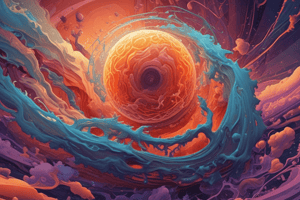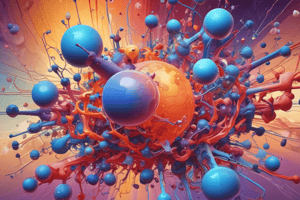Podcast
Questions and Answers
Matter is anything that has ______ and takes up space.
Matter is anything that has ______ and takes up space.
mass
In a ______ state, particles are closely packed and have a fixed position.
In a ______ state, particles are closely packed and have a fixed position.
solid
The process of changing from a liquid to a gas is called ______.
The process of changing from a liquid to a gas is called ______.
evaporation
Stars are examples of the ______ state of matter.
Stars are examples of the ______ state of matter.
When a solid changes directly to a gas without going through the liquid phase, it is called ______.
When a solid changes directly to a gas without going through the liquid phase, it is called ______.
The shape of a ______ is not fixed, but its volume is fixed.
The shape of a ______ is not fixed, but its volume is fixed.
Flashcards are hidden until you start studying
Study Notes
States of Matter
Definition
- Matter is anything that has mass and takes up space.
- It can exist in different forms, known as states of matter.
Types of States of Matter
- Solid:
- Particles are closely packed and have a fixed position.
- Shape and volume are fixed.
- Examples: rocks, metals, ice.
- Liquid:
- Particles are close together but can move past each other.
- Shape is not fixed, but volume is fixed.
- Examples: water, oil, juice.
- Gas:
- Particles are widely spaced and can move freely.
- Neither shape nor volume is fixed.
- Examples: air, helium, oxygen.
- Plasma:
- High-energy state where atoms are ionized.
- Particles are highly energetic and move freely.
- Examples: stars, lightning, neon signs.
Changes of State
- Melting: solid → liquid (increase in temperature).
- Freezing: liquid → solid (decrease in temperature).
- Evaporation: liquid → gas (increase in temperature).
- Condensation: gas → liquid (decrease in temperature).
- Sublimation: solid → gas (increase in temperature, without going through liquid phase).
- Deposition: gas → solid (decrease in temperature, without going through liquid phase).
States of Matter
Definition
- Matter has mass and occupies space.
Types of States of Matter
- Solid: closely packed particles with fixed position, fixed shape and volume, e.g. rocks, metals, ice.
- Liquid: closely packed particles that can move past each other, non-fixed shape, fixed volume, e.g. water, oil, juice.
- Gas: widely spaced particles that move freely, no fixed shape or volume, e.g. air, helium, oxygen.
- Plasma: high-energy state with ionized atoms, highly energetic particles that move freely, e.g. stars, lightning, neon signs.
Changes of State
- Melting: solid to liquid, increased temperature.
- Freezing: liquid to solid, decreased temperature.
- Evaporation: liquid to gas, increased temperature.
- Condensation: gas to liquid, decreased temperature.
- Sublimation: solid to gas, increased temperature, bypassing liquid phase.
- Deposition: gas to solid, decreased temperature, bypassing liquid phase.
Studying That Suits You
Use AI to generate personalized quizzes and flashcards to suit your learning preferences.




